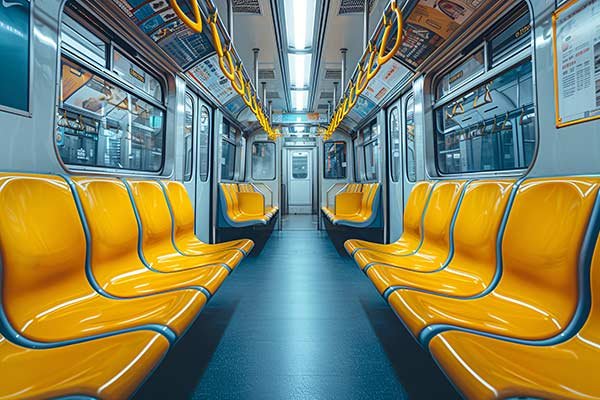Public transportation, such as buses, subways, and high-speed rails, has become increasingly important with the rapid urbanization. Public transportation systems, including subways, buses, and high-speed trains, have become an integral part of everyday travel. The high density of passengers and their frequent contact make the seats in public transport a breeding ground for bacteria and viruses. Antimicrobials have been used in seat materials for many years. This not only improves the health and safety of passengers but also offers innovative solutions for the sustainable operation of public transport. This article will explore the future development trends, as well as the technical principles and application scenarios of antimicrobials for public transport seats.
1. Hygiene Challenges of Public Transport Seats
The seats of public transport are contaminated by sweat, skin flakes, and food residues. This provides a breeding ground for microorganisms such as bacteria, viruses, and fungi. Researchers have found that there can be thousands of bacteria per square centimeter on the seats of buses and subways, including pathogens like Staphylococcus Aureus or Escherichia Coli. Chemical disinfectants can temporarily suppress microorganisms, but they have several drawbacks.
- Short-lived Effect: Microorganisms can regrow within a few hours after disinfection.
- High Labor Costs: Frequent cleaning is labor-intensive and requires a significant amount of time.
- Chemical Residues: Excessive use of disinfectants may have adverse effects on the skin and the environment.
Therefore, the public transport industry has shown interest in how to create antimicrobial materials with a long-lasting effect.
2. Antimicrobials: Principles and Types
Antimicrobials, also known as antimicrobial additives, are substances that kill or inhibit microorganisms through their ability to bind with other materials. They possess a persistent antimicrobial property and are primarily classified based on their composition and mechanisms of action.
1. Inorganic Antimicrobials
- Silver Ions (Ag+): Silver ions can kill bacteria by destroying cell membranes and interfering with DNA replication. They have a broad spectrum of action and a long-lasting effect.
- Copper-based Material: Copper (Cu2+), as a metal, has the ability to inactivate a wide range of pathogens. It is also effective against drug-resistant bacteria.
- Zinc Oxide (ZnO): Zinc Oxide generates reactive oxygen species through a photocatalytic reaction, which damages microbial structures.
2. Organic Antimicrobials
- Quaternary Ammonium Salts: They work by adsorbing onto the surface of microorganisms through positive charges and disrupting membrane permeability.
- Triclosan: This compound inhibits the synthesis of fatty acids in bacteria, but its environmental impact has limited its use.
3. Natural Extracts
- Chitosan: Extracted from shellfish and biodegradable, chitosan inhibits bacterial growth through electrostatic interaction.
- Essential oils: Tea tree oil, peppermint oil, and other essential oils have natural antibacterial properties, but their durability is limited.
Due to their safety, heat resistance, and stability, inorganic materials (especially copper-based and silver-based materials) are currently the most popular choice for public transport seats.
3. Antimicrobials for Seat Materials: Application Technologies
Integrating antimicrobials into seat materials requires balancing safety, durability, and effectiveness. Common technologies include:
- Fiber Coating Tech: Coating leather or seat fabrics with antimicrobial coatings that directly contact microorganisms to exert an antimicrobial effect. This technology is simple and cost-effective, but the coatings may wear off over time due to friction.
- Masterbatch Blending Technology: The antimicrobials in the masterbatch are blended with plastics or synthetic fibers (such as PU, PVC) and processed by injection molding, extrusion, etc. to produce antimicrobial components. This ensures an even distribution of antimicrobial properties and a service life lasting several years.
- Microcapsules Slow-Release Tech: Antimicrobials are encapsulated in microcapsules and embedded within the material. The slow release of active ingredients prolongs the antimicrobial effect, making this material suitable for long-term needs.
- 3D Integration Technology: By using 3D printing, antimicrobials can be precisely embedded into seat structures. This allows for customized designs with reduced waste.
4. Useful Case Studies and Effectiveness Testing
Many cities have adopted antimicrobial materials for seats in public transportation, achieving significant results.
- London Subway: In 2021, certain lines tested seats with silver-ion coated fabrics. The tests showed that the bacterial count was reduced by over 90%, and there was no sign of antibiotic resistance.
- Singapore Buses: The introduction of copper-based antimicrobial seat armrests led to a 23% improvement in passenger satisfaction and a 35% reduction in cleaning costs.
- Japan Shinkansen: Chitosan fibers are integrated into the first-class seats to reduce odors and allergies, enhancing the high-end travel experience.
According to laboratory tests, high-quality antimicrobial seat materials must meet the following criteria:
- Antimicrobial rate: >99% (against Escherichia coli, Staphylococcus aureus, etc.).
- Durability: Antimicrobial effectiveness remains > 95% after 5000 friction cycles.
- Safety: Conforms to the ISO 10993 biocompatibility standard, ensuring safety for humans.
5. Benefits and Challenges
Advantages
- Long-lasting Antimicrobial Effect: Reduces the frequency of cleaning and lowers operating costs.
- Benefits to Public Health: Reduces the risk of contamination, especially during flu seasons or pandemics.
- Ecofriendliness: Some antimicrobials, such as copper ions, can be recycled, supporting the concept of green transportation.
Challenges
- Cost Increase: Antimicrobial materials cost between 10% and 30% more than traditional materials.
- Lacking Standardization: There are no unified testing and certification systems for antimicrobial performance.
- Public Awareness: Some passengers are concerned about the safety and efficacy of antimicrobials, calling for more public education.
6. Future Trends & Innovation Directions
- Smart materials that respond: Create “smart” seats that adjust their antimicrobial activities according to changes in the environment (temperature, humidity, etc.).
- Nanotechnology: Use graphene, carbon nanotubes, etc. to improve antimicrobial effectiveness.
- Biodegradable Antimicrobials: Reduce the environmental impact of antimicrobials and promote a circular economy.
- Multimodal Protection: Combine antiviral, antimold, and antistaining functions to provide a comprehensive hygiene product.
Conclusion
Antimicrobial seats in public transportation are not only a breakthrough in materials science but also a significant innovation in the field of public health. As technology improves and costs decrease, antimicrobial seats are likely to become the “standard” for urban transport. They provide passengers with a more comfortable travel experience.


-300x210.jpg)
